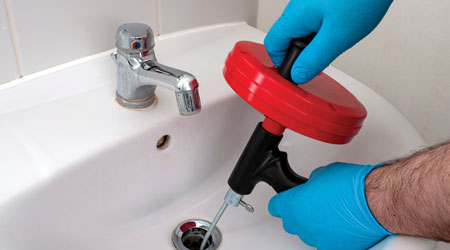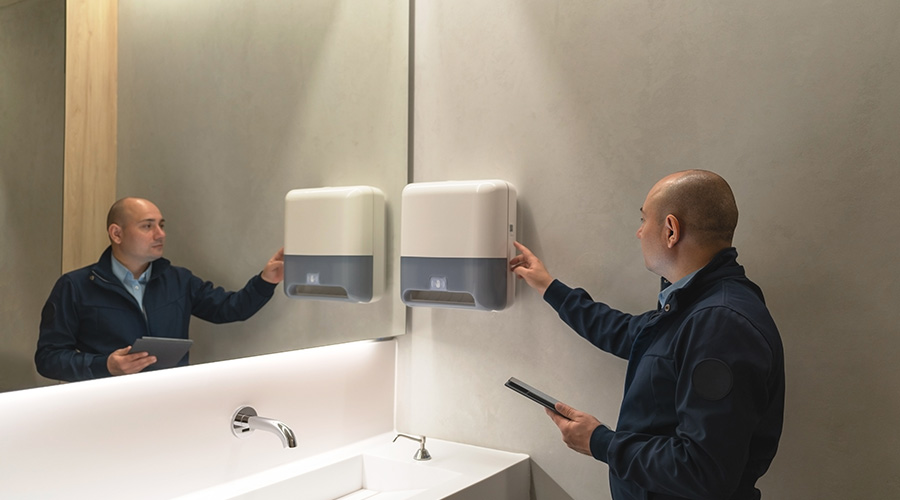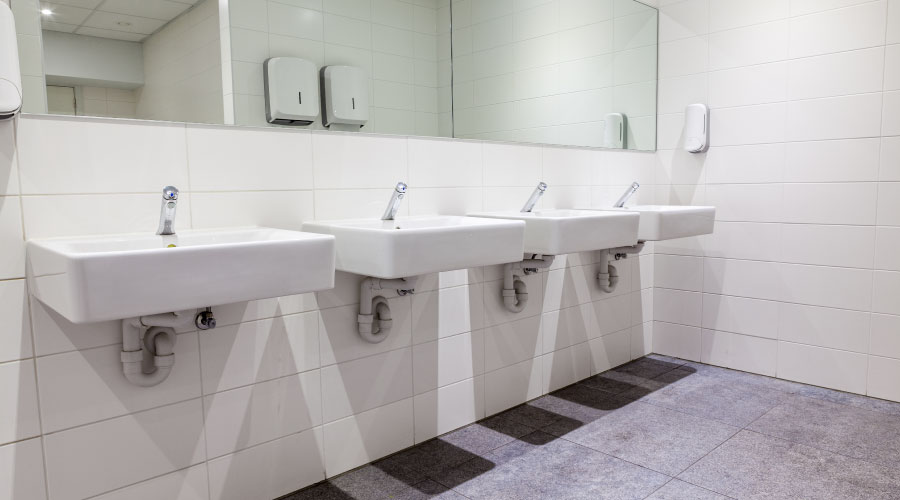How to Build An Effective Drain Cleaning Program
By focusing on equipment, tasks, and safety, managers can keep plumbing and piping flowing efficiently.
Drain cleaning is an often-overlooked yet vital task in institutional and commercial facilities and one that building occupants only think about when a problem occurs. But for maintenance and engineering managers and front-line technicians, ensuring the performance of facility piping and plumbing systems is a high priority.
For an organization’s plumbing and piping systems to perform reliably and efficiently, managers need to build and maintain an arsenal of drain cleaning and diagnostic equipment, and they need to ensure technicians perform essential tasks regularly and use the equipment in a safe manner.
Building an arsenal
Mechanical drain cleaning equipment includes hand-powered sink and small drain cleaners, power augers and drum cleaners for longer drains, jetters, and large sectional and drum cleaners for cleaning main drains. Technicians can effectively clean and clear all types of blockages with these tools, along with safety equipment, drain cameras, recorders, and pipeline locators.
This arsenal of tools is designed to enable technicians to address problems in key areas of plumbing and piping systems, from sink traps to major underground laterals and mains that discharge into waste treatment plants.
A drain cleaner uses a bulb auger attachment to remove soft material and a hook auger to break up hard materials, such as tree roots. Auger kits with a range of attachments are available.
Other drain cleaning tools, such as flexible manual snakes with thousands of small hooks, are effective in removing soft clogs, including paper, hair, and sanitary products. For longer drains, technicians can use sectional versions of the hand-powered snake that reach farther into the drain. The cable is stored in the drum of some section cleaners. The technician unreels the first 10-foot section from the drum into the pipeline, feeds it, then connects the next section to the first. Sections are added to reach the necessary distance into the pipeline.
Hydrojetters are important components of a plumber’s arsenal. These tools have nozzles with one water jet pointing forward and four jets pointing backward. With water flowing through the nozzles at 4,000 psi, the high-velocity forward-facing jet clears the pipeline, and the backward-facing jets propel the nozzle into the pipeline and through the blockage.
Diagnostics: An inside look
Technicians can spend a great deal of time diagnosing a plumbing problem and its location — often inside walls and floors and underground — and the best diagnostic tools for drain cleaning can shorten this phase of the job.
Tools for pipeline diagnosis include flashlight, tape measure, camera, recorder, and pipeline locator. A video pipeline inspection system uses non-destructive closed-circuit television to find blockages, lateral taps, bellies — sagging older pipelines — and pipe-buckling damage in mains and laterals without digging or destroying the pipeline.
Bellies can be difficult to diagnose. Symptoms include flushing one toilet and causing rippling of water in another toilet, as well as drain line odor back-up due to water in the belly blocking off gas flow to the vent. In this case, the only solution is to find the section with the belly and replace that section.
Common targets of diagnostic drain cleaning technology include: sagging pipelines; old and rusted galvanized pipe; tree root blockages; soft and hard objects in piping; and coronavirus in the sewer water.
A\n electronic pipeline locator finds the pipeline, measures and records its depth, and shows the depth on screen. This equipment saves technicians from having to dig up the pipeline. The transmitter creates a signal at a certain frequency in hertz (Hz). It travels along the pipe creating an electromagnetic field. The field produces radio waves that travel back to the reader and indicate the depth and orientation of the pipeline.
Measuring the wall thickness of aging piping and comparing it to standard pipe wall thickness shows technicians the amount the walls have thinned due to erosion and corrosion. Measurement methods include ultrasonic testing and test specimens inserted into the piping.
Using this method, the technician drills a hole in the pipe at the location of the desired thickness reading. The technician welds a threaded fitting over the hole and fastens a test specimen of the same metal and thickness as the piping. The rate of wear on the specimen will equal the rate of wear on the piping. If the specimen has lost 0.010 inch after two years, the pipe thickness will have lost the same amount.
The best time to insert the specimen is when the pipe is new, but it is never too late to use this type of measurement. Installing it when the pipe is new gives the advantages of a longer measurement period to gauge wall thickness reduction.
A vibration analyzer also is a valuable tool for diagnosing problems related to drain pumps and electric drain cleaners. In the case of a sump pump, the vibration analyzer can detect vibrations in the sump pump or drain cleaner motor. But what level of vibration is allowable before the motor reaches the point of failure? The vibration analyzer measures frequency and amplitude of vibrations.
Technicians can consult a general severity chart. The frequency readings will point to the part failing, and the amplitude reading point to the severity.
If the readings show the highest frequency at 1,750 rpm and the motor shaft turns at 1,750 rpm, the problem is a bent shaft. If it is a high multiple of shaft rpm, the cause is the bearings. If the reading is four times the rpm and the pump has a four-bladed impeller, the cause is the impeller.
The amplitude of the vibration compared to a general severity chart can predict the remaining life and when it is likely to reach a critical point. This can help the technician determine when to order parts before the vibration causes the motor to fail, and it allows enough time for a routine, scheduled replacement or repair of the motor.
Preventing problems
A robust arsenal of drain cleaning tools — both mechanical snakes and hydrojetting tools, for example — enables front-line technicians to handle both routine tasks and complex processes.
Tests have shown that some jobs require clearing clogs then flushing the pipeline to remove the debris. This is a longer, two-step operation with a drum or section machine, which is not as effective in cleaning pipeline walls. A hydrojetter accomplishes the job in less time and in one step.
Also, buildings might have outside foundation drains to keep rain and melted snow from building up outside the foundation, getting into the water table, creating pressure, and even resulting in cracks in basement or underground garage walls.
Sump pumps also are important drain cleaning tools. The drains connect to inside sump pumps that collect the water and pump it out in collector drains to the waste treatment plant. If a sump pump fails, water buildup against the walls will cause enough pressure that the walls will crack and leak into the building, causing damage to anything stored inside or vehicles in an underground garage. It also can further damage the foundation walls.
This is one example of a seemingly minor maintenance cost avoiding a major repair cost. If an annual inspection checklist includes sump pumps, a building is not likely to see damage to property and wall cracks in the foundation. This inspection can be as routine as manually lifting the float in the sump pump well to start the pump, then listening and feeling for unusual vibration.
A technician using a portable vibration analyzer can tell exactly when to perform other repairs. If the impeller or bearings are near the end of life, they can detect this in time to schedule repairs before failure occurs. Even if they have to replace the sump pump, it is much less expensive than the cost of repairs because of building damage.
Safety considerations
While drain cleaning can seem like a relatively safe operation, the presence of spinning metal and contaminated liquids present technicians with very real threats to safety. The COVID-19 pandemic has only added to the list of possible threats.
A safety kit for drain cleaning should include rope, fall protection, rubber safety and leather gloves, and face protection. Personal protection equipment (PPE) is more important now since it helps technicians to work safely. Items include eye, nose and mouth protection, as well as leather gloves to be worn over rubber gloves to avoid punctures while contacting wastewater that might contain coronavirus or other dangerous contaminants. Technicians also need towels and wipes to clean and disinfect tools, work clothes and PPE.
For cleaning solid surfaces, technicians should clean with soap and water to remove debris and dust, then disinfect the surface as outlined by CDC using five tablespoons of vinegar per gallon of water or other recommended disinfectants. OSHA recommends that technicians performing drain cleaning tasks receive Hepatitis B shots, wash their hands often, and avoid touching their faces. The reason guidelines vary is that coronavirus variants and transmissibility vary. Also, the number and severity of cases vary with time and location. The solution is to keep checking the guidelines.
COVID-19 shows signs of increasing nationwide, even though vaccines have been successful. More than one-half of new cases are tied to the more easily transmitted delta variant. Tests of sewer water have shown that 10 times the number of Coronavirus cases may be present in a population than have been found. So drain cleaners, while improving the health of their facilities, still must be careful to follow special safety and health measures.
Thomas A. Westerkamp is a maintenance and engineering management consultant and president of the work management division of Westerkamp Group LLC.
Related Topics:












